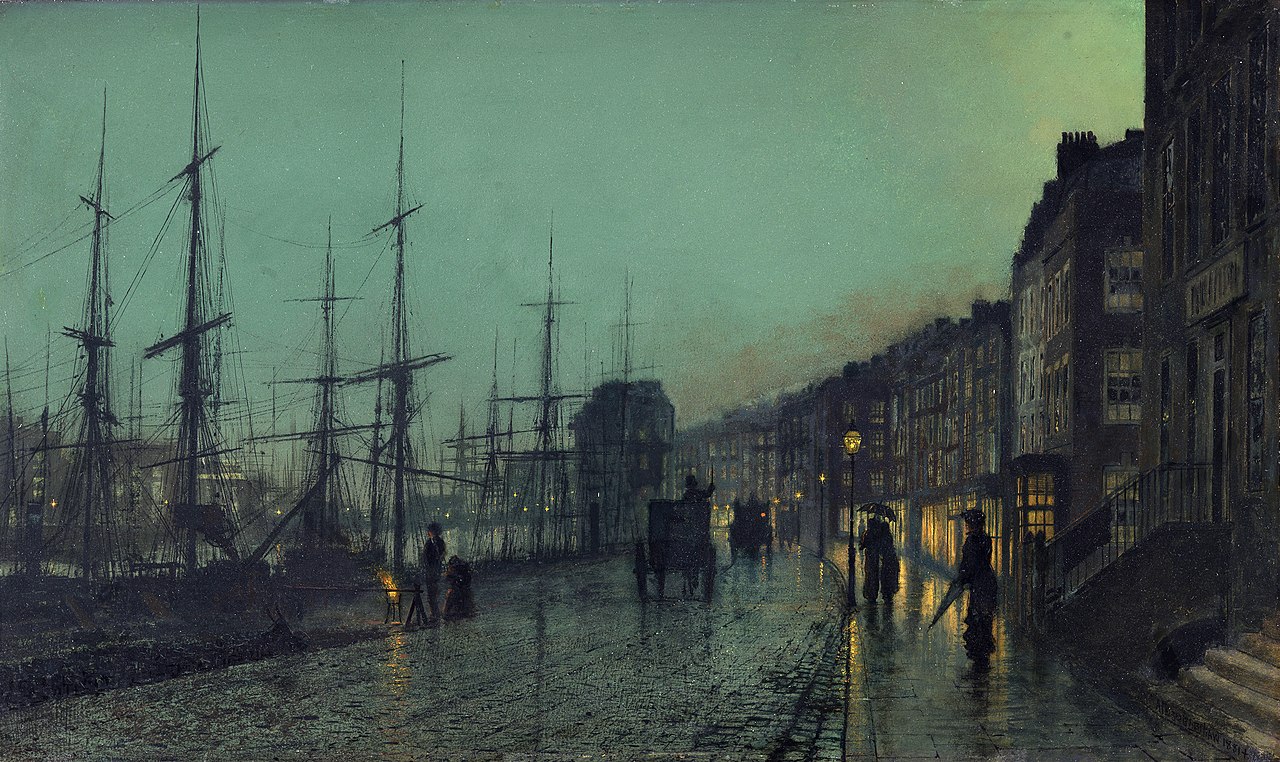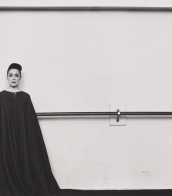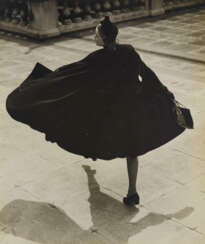кинсон


John Atkinson Grimshaw was an English Victorian-era artist best known for his nocturnal scenes of urban landscapes. He was called a «remarkable and imaginative painter» by the critic and historian Christopher Wood in Victorian Painting (1999).
Grimshaw's love for realism stemmed from a passion for photography, which would eventually lend itself to the creative process. Though entirely self-taught, he is known to have used a camera obscura or lenses to project scenes onto canvas, which made up for his shortcomings as a draughtsman and his imperfect knowledge of perspective. This technique, which Caravaggio and Vermeer may also have used, was condemned by a number of his contemporaries who believed it demonstrated less skill than painting by eye, with some claiming that his paintings appeared to «show no marks of handling or brushwork», while others "were doubtful whether they could be accepted as paintings at all". However, many recognised his mastery of colour, lighting and shadow, as well as his unique ability to provoke strong emotional responses in the viewer. James McNeill Whistler, who Grimshaw worked with in his Chelsea studios, stated, «I considered myself the inventor of nocturnes until I saw Grimmy's moonlit pictures».


John Atkinson Grimshaw was an English Victorian-era artist best known for his nocturnal scenes of urban landscapes. He was called a «remarkable and imaginative painter» by the critic and historian Christopher Wood in Victorian Painting (1999).
Grimshaw's love for realism stemmed from a passion for photography, which would eventually lend itself to the creative process. Though entirely self-taught, he is known to have used a camera obscura or lenses to project scenes onto canvas, which made up for his shortcomings as a draughtsman and his imperfect knowledge of perspective. This technique, which Caravaggio and Vermeer may also have used, was condemned by a number of his contemporaries who believed it demonstrated less skill than painting by eye, with some claiming that his paintings appeared to «show no marks of handling or brushwork», while others "were doubtful whether they could be accepted as paintings at all". However, many recognised his mastery of colour, lighting and shadow, as well as his unique ability to provoke strong emotional responses in the viewer. James McNeill Whistler, who Grimshaw worked with in his Chelsea studios, stated, «I considered myself the inventor of nocturnes until I saw Grimmy's moonlit pictures».


John Atkinson Grimshaw was an English Victorian-era artist best known for his nocturnal scenes of urban landscapes. He was called a «remarkable and imaginative painter» by the critic and historian Christopher Wood in Victorian Painting (1999).
Grimshaw's love for realism stemmed from a passion for photography, which would eventually lend itself to the creative process. Though entirely self-taught, he is known to have used a camera obscura or lenses to project scenes onto canvas, which made up for his shortcomings as a draughtsman and his imperfect knowledge of perspective. This technique, which Caravaggio and Vermeer may also have used, was condemned by a number of his contemporaries who believed it demonstrated less skill than painting by eye, with some claiming that his paintings appeared to «show no marks of handling or brushwork», while others "were doubtful whether they could be accepted as paintings at all". However, many recognised his mastery of colour, lighting and shadow, as well as his unique ability to provoke strong emotional responses in the viewer. James McNeill Whistler, who Grimshaw worked with in his Chelsea studios, stated, «I considered myself the inventor of nocturnes until I saw Grimmy's moonlit pictures».


William Page Atkinson Wells was a Scottish impressionist painter who specialised in rural landscapes and domestic scenes.


Norman Parkinson was a renowned British photographer who is considered one of the most influential fashion photographers of the 20th century. Parkinson began his career in the 1930s and continued to work until his death.
Throughout his career, Parkinson worked for numerous fashion magazines, including Vogue, Harper's Bazaar, and Queen. He was known for his use of vibrant colors and his ability to capture his subjects in dynamic poses and interesting settings. Parkinson's photographs often had a sense of humor and playfulness, and he was known for his ability to put his models at ease, resulting in natural and spontaneous photographs.
Parkinson's work has been exhibited in galleries and museums around the world, and he has been the subject of numerous books and documentaries. He received numerous awards throughout his career, including the Royal Photographic Society's Centenary Medal in 1985.


Norman Parkinson was a renowned British photographer who is considered one of the most influential fashion photographers of the 20th century. Parkinson began his career in the 1930s and continued to work until his death.
Throughout his career, Parkinson worked for numerous fashion magazines, including Vogue, Harper's Bazaar, and Queen. He was known for his use of vibrant colors and his ability to capture his subjects in dynamic poses and interesting settings. Parkinson's photographs often had a sense of humor and playfulness, and he was known for his ability to put his models at ease, resulting in natural and spontaneous photographs.
Parkinson's work has been exhibited in galleries and museums around the world, and he has been the subject of numerous books and documentaries. He received numerous awards throughout his career, including the Royal Photographic Society's Centenary Medal in 1985.


Norman Parkinson was a renowned British photographer who is considered one of the most influential fashion photographers of the 20th century. Parkinson began his career in the 1930s and continued to work until his death.
Throughout his career, Parkinson worked for numerous fashion magazines, including Vogue, Harper's Bazaar, and Queen. He was known for his use of vibrant colors and his ability to capture his subjects in dynamic poses and interesting settings. Parkinson's photographs often had a sense of humor and playfulness, and he was known for his ability to put his models at ease, resulting in natural and spontaneous photographs.
Parkinson's work has been exhibited in galleries and museums around the world, and he has been the subject of numerous books and documentaries. He received numerous awards throughout his career, including the Royal Photographic Society's Centenary Medal in 1985.


John Atkinson Grimshaw was an English Victorian-era artist best known for his nocturnal scenes of urban landscapes. He was called a «remarkable and imaginative painter» by the critic and historian Christopher Wood in Victorian Painting (1999).
Grimshaw's love for realism stemmed from a passion for photography, which would eventually lend itself to the creative process. Though entirely self-taught, he is known to have used a camera obscura or lenses to project scenes onto canvas, which made up for his shortcomings as a draughtsman and his imperfect knowledge of perspective. This technique, which Caravaggio and Vermeer may also have used, was condemned by a number of his contemporaries who believed it demonstrated less skill than painting by eye, with some claiming that his paintings appeared to «show no marks of handling or brushwork», while others "were doubtful whether they could be accepted as paintings at all". However, many recognised his mastery of colour, lighting and shadow, as well as his unique ability to provoke strong emotional responses in the viewer. James McNeill Whistler, who Grimshaw worked with in his Chelsea studios, stated, «I considered myself the inventor of nocturnes until I saw Grimmy's moonlit pictures».


John Atkinson Grimshaw was an English Victorian-era artist best known for his nocturnal scenes of urban landscapes. He was called a «remarkable and imaginative painter» by the critic and historian Christopher Wood in Victorian Painting (1999).
Grimshaw's love for realism stemmed from a passion for photography, which would eventually lend itself to the creative process. Though entirely self-taught, he is known to have used a camera obscura or lenses to project scenes onto canvas, which made up for his shortcomings as a draughtsman and his imperfect knowledge of perspective. This technique, which Caravaggio and Vermeer may also have used, was condemned by a number of his contemporaries who believed it demonstrated less skill than painting by eye, with some claiming that his paintings appeared to «show no marks of handling or brushwork», while others "were doubtful whether they could be accepted as paintings at all". However, many recognised his mastery of colour, lighting and shadow, as well as his unique ability to provoke strong emotional responses in the viewer. James McNeill Whistler, who Grimshaw worked with in his Chelsea studios, stated, «I considered myself the inventor of nocturnes until I saw Grimmy's moonlit pictures».


John Atkinson Grimshaw was an English Victorian-era artist best known for his nocturnal scenes of urban landscapes. He was called a «remarkable and imaginative painter» by the critic and historian Christopher Wood in Victorian Painting (1999).
Grimshaw's love for realism stemmed from a passion for photography, which would eventually lend itself to the creative process. Though entirely self-taught, he is known to have used a camera obscura or lenses to project scenes onto canvas, which made up for his shortcomings as a draughtsman and his imperfect knowledge of perspective. This technique, which Caravaggio and Vermeer may also have used, was condemned by a number of his contemporaries who believed it demonstrated less skill than painting by eye, with some claiming that his paintings appeared to «show no marks of handling or brushwork», while others "were doubtful whether they could be accepted as paintings at all". However, many recognised his mastery of colour, lighting and shadow, as well as his unique ability to provoke strong emotional responses in the viewer. James McNeill Whistler, who Grimshaw worked with in his Chelsea studios, stated, «I considered myself the inventor of nocturnes until I saw Grimmy's moonlit pictures».


John Atkinson Grimshaw was an English Victorian-era artist best known for his nocturnal scenes of urban landscapes. He was called a «remarkable and imaginative painter» by the critic and historian Christopher Wood in Victorian Painting (1999).
Grimshaw's love for realism stemmed from a passion for photography, which would eventually lend itself to the creative process. Though entirely self-taught, he is known to have used a camera obscura or lenses to project scenes onto canvas, which made up for his shortcomings as a draughtsman and his imperfect knowledge of perspective. This technique, which Caravaggio and Vermeer may also have used, was condemned by a number of his contemporaries who believed it demonstrated less skill than painting by eye, with some claiming that his paintings appeared to «show no marks of handling or brushwork», while others "were doubtful whether they could be accepted as paintings at all". However, many recognised his mastery of colour, lighting and shadow, as well as his unique ability to provoke strong emotional responses in the viewer. James McNeill Whistler, who Grimshaw worked with in his Chelsea studios, stated, «I considered myself the inventor of nocturnes until I saw Grimmy's moonlit pictures».


John Atkinson Grimshaw was an English Victorian-era artist best known for his nocturnal scenes of urban landscapes. He was called a «remarkable and imaginative painter» by the critic and historian Christopher Wood in Victorian Painting (1999).
Grimshaw's love for realism stemmed from a passion for photography, which would eventually lend itself to the creative process. Though entirely self-taught, he is known to have used a camera obscura or lenses to project scenes onto canvas, which made up for his shortcomings as a draughtsman and his imperfect knowledge of perspective. This technique, which Caravaggio and Vermeer may also have used, was condemned by a number of his contemporaries who believed it demonstrated less skill than painting by eye, with some claiming that his paintings appeared to «show no marks of handling or brushwork», while others "were doubtful whether they could be accepted as paintings at all". However, many recognised his mastery of colour, lighting and shadow, as well as his unique ability to provoke strong emotional responses in the viewer. James McNeill Whistler, who Grimshaw worked with in his Chelsea studios, stated, «I considered myself the inventor of nocturnes until I saw Grimmy's moonlit pictures».


John Atkinson Grimshaw was an English Victorian-era artist best known for his nocturnal scenes of urban landscapes. He was called a «remarkable and imaginative painter» by the critic and historian Christopher Wood in Victorian Painting (1999).
Grimshaw's love for realism stemmed from a passion for photography, which would eventually lend itself to the creative process. Though entirely self-taught, he is known to have used a camera obscura or lenses to project scenes onto canvas, which made up for his shortcomings as a draughtsman and his imperfect knowledge of perspective. This technique, which Caravaggio and Vermeer may also have used, was condemned by a number of his contemporaries who believed it demonstrated less skill than painting by eye, with some claiming that his paintings appeared to «show no marks of handling or brushwork», while others "were doubtful whether they could be accepted as paintings at all". However, many recognised his mastery of colour, lighting and shadow, as well as his unique ability to provoke strong emotional responses in the viewer. James McNeill Whistler, who Grimshaw worked with in his Chelsea studios, stated, «I considered myself the inventor of nocturnes until I saw Grimmy's moonlit pictures».


Norman Parkinson was a renowned British photographer who is considered one of the most influential fashion photographers of the 20th century. Parkinson began his career in the 1930s and continued to work until his death.
Throughout his career, Parkinson worked for numerous fashion magazines, including Vogue, Harper's Bazaar, and Queen. He was known for his use of vibrant colors and his ability to capture his subjects in dynamic poses and interesting settings. Parkinson's photographs often had a sense of humor and playfulness, and he was known for his ability to put his models at ease, resulting in natural and spontaneous photographs.
Parkinson's work has been exhibited in galleries and museums around the world, and he has been the subject of numerous books and documentaries. He received numerous awards throughout his career, including the Royal Photographic Society's Centenary Medal in 1985.


John Atkinson Grimshaw was an English Victorian-era artist best known for his nocturnal scenes of urban landscapes. He was called a «remarkable and imaginative painter» by the critic and historian Christopher Wood in Victorian Painting (1999).
Grimshaw's love for realism stemmed from a passion for photography, which would eventually lend itself to the creative process. Though entirely self-taught, he is known to have used a camera obscura or lenses to project scenes onto canvas, which made up for his shortcomings as a draughtsman and his imperfect knowledge of perspective. This technique, which Caravaggio and Vermeer may also have used, was condemned by a number of his contemporaries who believed it demonstrated less skill than painting by eye, with some claiming that his paintings appeared to «show no marks of handling or brushwork», while others "were doubtful whether they could be accepted as paintings at all". However, many recognised his mastery of colour, lighting and shadow, as well as his unique ability to provoke strong emotional responses in the viewer. James McNeill Whistler, who Grimshaw worked with in his Chelsea studios, stated, «I considered myself the inventor of nocturnes until I saw Grimmy's moonlit pictures».


John Atkinson Grimshaw was an English Victorian-era artist best known for his nocturnal scenes of urban landscapes. He was called a «remarkable and imaginative painter» by the critic and historian Christopher Wood in Victorian Painting (1999).
Grimshaw's love for realism stemmed from a passion for photography, which would eventually lend itself to the creative process. Though entirely self-taught, he is known to have used a camera obscura or lenses to project scenes onto canvas, which made up for his shortcomings as a draughtsman and his imperfect knowledge of perspective. This technique, which Caravaggio and Vermeer may also have used, was condemned by a number of his contemporaries who believed it demonstrated less skill than painting by eye, with some claiming that his paintings appeared to «show no marks of handling or brushwork», while others "were doubtful whether they could be accepted as paintings at all". However, many recognised his mastery of colour, lighting and shadow, as well as his unique ability to provoke strong emotional responses in the viewer. James McNeill Whistler, who Grimshaw worked with in his Chelsea studios, stated, «I considered myself the inventor of nocturnes until I saw Grimmy's moonlit pictures».


Norman Parkinson was a renowned British photographer who is considered one of the most influential fashion photographers of the 20th century. Parkinson began his career in the 1930s and continued to work until his death.
Throughout his career, Parkinson worked for numerous fashion magazines, including Vogue, Harper's Bazaar, and Queen. He was known for his use of vibrant colors and his ability to capture his subjects in dynamic poses and interesting settings. Parkinson's photographs often had a sense of humor and playfulness, and he was known for his ability to put his models at ease, resulting in natural and spontaneous photographs.
Parkinson's work has been exhibited in galleries and museums around the world, and he has been the subject of numerous books and documentaries. He received numerous awards throughout his career, including the Royal Photographic Society's Centenary Medal in 1985.


Norman Parkinson was a renowned British photographer who is considered one of the most influential fashion photographers of the 20th century. Parkinson began his career in the 1930s and continued to work until his death.
Throughout his career, Parkinson worked for numerous fashion magazines, including Vogue, Harper's Bazaar, and Queen. He was known for his use of vibrant colors and his ability to capture his subjects in dynamic poses and interesting settings. Parkinson's photographs often had a sense of humor and playfulness, and he was known for his ability to put his models at ease, resulting in natural and spontaneous photographs.
Parkinson's work has been exhibited in galleries and museums around the world, and he has been the subject of numerous books and documentaries. He received numerous awards throughout his career, including the Royal Photographic Society's Centenary Medal in 1985.


John Atkinson Grimshaw was an English Victorian-era artist best known for his nocturnal scenes of urban landscapes. He was called a «remarkable and imaginative painter» by the critic and historian Christopher Wood in Victorian Painting (1999).
Grimshaw's love for realism stemmed from a passion for photography, which would eventually lend itself to the creative process. Though entirely self-taught, he is known to have used a camera obscura or lenses to project scenes onto canvas, which made up for his shortcomings as a draughtsman and his imperfect knowledge of perspective. This technique, which Caravaggio and Vermeer may also have used, was condemned by a number of his contemporaries who believed it demonstrated less skill than painting by eye, with some claiming that his paintings appeared to «show no marks of handling or brushwork», while others "were doubtful whether they could be accepted as paintings at all". However, many recognised his mastery of colour, lighting and shadow, as well as his unique ability to provoke strong emotional responses in the viewer. James McNeill Whistler, who Grimshaw worked with in his Chelsea studios, stated, «I considered myself the inventor of nocturnes until I saw Grimmy's moonlit pictures».


John Atkinson Grimshaw was an English Victorian-era artist best known for his nocturnal scenes of urban landscapes. He was called a «remarkable and imaginative painter» by the critic and historian Christopher Wood in Victorian Painting (1999).
Grimshaw's love for realism stemmed from a passion for photography, which would eventually lend itself to the creative process. Though entirely self-taught, he is known to have used a camera obscura or lenses to project scenes onto canvas, which made up for his shortcomings as a draughtsman and his imperfect knowledge of perspective. This technique, which Caravaggio and Vermeer may also have used, was condemned by a number of his contemporaries who believed it demonstrated less skill than painting by eye, with some claiming that his paintings appeared to «show no marks of handling or brushwork», while others "were doubtful whether they could be accepted as paintings at all". However, many recognised his mastery of colour, lighting and shadow, as well as his unique ability to provoke strong emotional responses in the viewer. James McNeill Whistler, who Grimshaw worked with in his Chelsea studios, stated, «I considered myself the inventor of nocturnes until I saw Grimmy's moonlit pictures».


John Atkinson Grimshaw was an English Victorian-era artist best known for his nocturnal scenes of urban landscapes. He was called a «remarkable and imaginative painter» by the critic and historian Christopher Wood in Victorian Painting (1999).
Grimshaw's love for realism stemmed from a passion for photography, which would eventually lend itself to the creative process. Though entirely self-taught, he is known to have used a camera obscura or lenses to project scenes onto canvas, which made up for his shortcomings as a draughtsman and his imperfect knowledge of perspective. This technique, which Caravaggio and Vermeer may also have used, was condemned by a number of his contemporaries who believed it demonstrated less skill than painting by eye, with some claiming that his paintings appeared to «show no marks of handling or brushwork», while others "were doubtful whether they could be accepted as paintings at all". However, many recognised his mastery of colour, lighting and shadow, as well as his unique ability to provoke strong emotional responses in the viewer. James McNeill Whistler, who Grimshaw worked with in his Chelsea studios, stated, «I considered myself the inventor of nocturnes until I saw Grimmy's moonlit pictures».











![[Alexandre BENOIS (1881-1962)]](/assets/image/picture_144776/2b864/dte1eadu3hje5q6wp2gvnnx9u0997bpbd9885lgcyyxd1kn37ay8mrlu38vvsgh1523312652jpg__fix_374_244.jpeg)
![[Alexandre BENOIS (1881-1962)]](https://veryimportantlot.com/assets/image/picture_144776/2b864/dte1eadu3hje5q6wp2gvnnx9u0997bpbd9885lgcyyxd1kn37ay8mrlu38vvsgh1523312652jpg__fix_374_244.jpeg)

























































